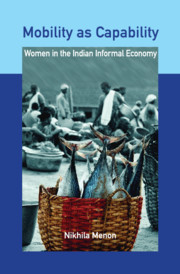Book contents
- Frontmatter
- Dedication
- Contents
- List of Tables
- List of Figures
- Preface
- 1 Transformational Mobility as Capability
- 2 Reflections on Transformational Mobility, Autonomy, and Women's Work
- 3 Women in ‘Kerala Model’: Myths and Realities
- 4 Situating Informal Work by Women in Fisheries in Kerala
- 5 ‘Measuring Mobility’ of Women: Unravelling the ‘Explicit’ and the ‘Implicit’
- 6 Pathways to Transformational Mobility of Women Workers: A Qualitative Comparative Analysis
- 7 ‘Subordinating Self’: ‘Manoeuvring Patriarchy’ among Women Workers
- 8 Self-Categorization, Group Identity, and Agency among Women Fish Vendors
- 9 Transformational Mobility: From Individual to Collective Agency of Informal Women Workers
- Bibliography
- Index
8 - Self-Categorization, Group Identity, and Agency among Women Fish Vendors
Published online by Cambridge University Press: 24 May 2020
- Frontmatter
- Dedication
- Contents
- List of Tables
- List of Figures
- Preface
- 1 Transformational Mobility as Capability
- 2 Reflections on Transformational Mobility, Autonomy, and Women's Work
- 3 Women in ‘Kerala Model’: Myths and Realities
- 4 Situating Informal Work by Women in Fisheries in Kerala
- 5 ‘Measuring Mobility’ of Women: Unravelling the ‘Explicit’ and the ‘Implicit’
- 6 Pathways to Transformational Mobility of Women Workers: A Qualitative Comparative Analysis
- 7 ‘Subordinating Self’: ‘Manoeuvring Patriarchy’ among Women Workers
- 8 Self-Categorization, Group Identity, and Agency among Women Fish Vendors
- 9 Transformational Mobility: From Individual to Collective Agency of Informal Women Workers
- Bibliography
- Index
Summary
I see vendors as small entrepreneurs who grow ever so organically; they are a true and direct expression of a lively economy.
—Ela R. Bhatt (2006)The freedom to seek employment outside the household is systematically denied to women in many cultures, which is in fact a violation of women's liberty. In several instances, the denial is implicit through the power of convention and conformity. To break the ‘social barriers’ and to bring working outside the household ‘centre stage’ as the ‘new normal’ for women requires complementary efforts by non-market institutions, especially for the marginalized sections of society like that of the fishing communities. The fishing communities in Kerala are marginalized sections with very high levels of poverty. Hence, in the absence of organizations like Self Employed Women's Association (SEWA), the participation of women of fishing communities in south Kerala in marketing/vending fish is in one way a reflection of the entrepreneurial spirit triggered by poverty and lack of livelihood options. Participating in markets can be liberating and empowering for women, not only economically but also at the individual level of enhancing their capabilities and thereby aspirations. Mobility associated with paid work outside the household has a capability-enhancing effect. However, many times, owing to exploitative conditions of the work, this may not result in human flourishing. The trajectory from work to welfare is non-linear.
For the analysis of mobility, autonomy, and agency of women in informal work, I chose women fish vendors as the second group of workers in the fisheries sector because of the very unique nature of the work of the women vendors, which makes them one of the most mobile groups of informal workers in fisheries. They are in direct contrast to the peeling workers who are based in a factory setting. Moreover, as an informal self-employed group of workers, women fish vendors have a critical role in the fisheries sector as well as in the society. They are a reflection of the entrepreneurial spirit in fisheries.
Power of convention versus power of market: case of women fish vendors
Fish vending is an important informal activity in the fisheries sector. In Kerala, women entered into the men's bastion of fish vending around thirty-five years ago. It is still confined to the districts of south Kerala, namely Thiruvananthapuram, Kollam, and Alappuzha.
- Type
- Chapter
- Information
- Mobility as CapabilityWomen in the Indian Informal Economy, pp. 136 - 152Publisher: Cambridge University PressPrint publication year: 2021

